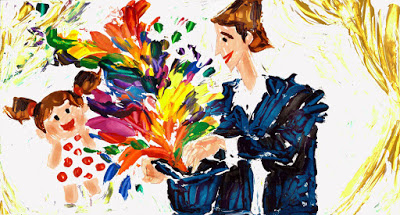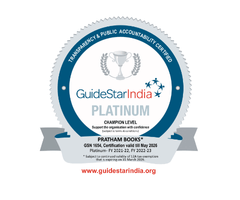Language, the Magical Scarf

DNA. My paternal grandfather, a lawyer by profession, briefly taught
English literature at the University of Srinagar. When teaching
Wordsworth’s poetry, he would insist on taking the class on a shikaara on
Dal lake to create a more immersive learning experience for his students.
He also translated Saratchandra’s works from Bengali to Hindi. My
father, though a Science student, joined Russian and later German classes
at the University just because he was interested in learning new
languages. My mother tongue is Hindi. That is what I grew up speaking at home
and there was no hierarchy of languages as I see around me today, with
English sitting atop like a prima donna. Many a visiting family friend was
caught off guard when I would request them to tell me a story. They
would often try to get out of it by saying they didn’t know any stories and
were stumped when I would tell them that they had to listen to me
tell one then!
read Hindi and English story books. Being an only child and growing up
in a pre computer era added to the time I spent with books. Whenever my
parents or visiting aunts or uncles would ask what I would like as a gift, it
was always story books. Browsing in a bookshop was done as often as
going to a restaurant or a movie and as a child I used to think a bookshop
owner is the richest and luckiest person in the world!
living on a verdant 70 acre campus also had the advantage of having
access to the library during the holidays too. The joy of discovering C S
Lewis in the musty pages of a yellowing ‘The lion, the witch and the
wardrobe’ in the high ceilinged interiors of an ivy covered library is just
one of the innumerable jewels which lie sparkling in my memory.
to a life long love for language in all its forms and the choices of work I
made later on have always been a variation of these. I know only two
languages and hope I will learn at least one more in this lifetime.
Bombay when we were living there in the mid nineties. She spoke Hindi,
English and Gujarati but also Tamil, thanks to the Tamilian neighbours
whose house was like an extension of her own and a bit of Marathi,
thanks to the help in their house. So at that young age she was proficient
in five languages, switching from one to the other with ease depending on
who she was speaking to! I sincerely believe that instead of being ‘taught’
a language in the primary years, children must be encouraged to ‘play’
with multiple languages as the window for language learning is open
widest in those impressionable years. A sound and natural foundation of
speaking in one’s mother tongue, cannot be replaced by the artificial
imposition of a foreign language. This foundation is what develops a love
for languages and motivates children to keep learning and enjoying them.
Speaking in one’s mother tongue is an important aspect of who you are, it
is an integral part of your identity. I tell young children that if they only
speak in English, when they visit other countries and people ask about
their language, what will they say? It will be a classic case of being a
‘dhobi ka gadhaa; na ghar ka na ghaat ka’!
childhood friend and her 3 year old daughter. The friend’s mother in law
was also there. She was a warm, cheerful lady who was actively involved
in social work. Like my own mother and most of the mothers of my
friends in North India, she spoke only Hindi. Her grandchild, however,
was being brought up by the parents on an exclusive diet of English with
the result that the conversation between the grand mother and her
grandchild was limited to monosyllables like ‘yes’, ‘no’, ‘sit’ etc. I was
appalled to see that my friend was completely unaware of the richness of
experience she was depriving her child of. Communication with a grand
parent is such a precious part of childhood and the child was being
deprived of the multilayered joy and learning from it. More recently, it
was heartening to see an everyday experience of a bygone era in urban
life, alive and kicking in a small hill town: a child holding his
grandfather’s hand and prancing down the street, conversing- in his
mother tongue of course.
the child’s high pitched voice, posing short questions, alternating with the
grandfather’s gravelly slower tone, stretching longer, was delightful to
the ears as was the sight of the two of them strolling down the road,
communicating the wisdom of generations, in a language understood by
both. The repercussions of not speaking the mother tongue are like the
momentary tremors of an earthquake: an indicator of a greater movement
at a far deeper level. It reminds me of stories where seemingly
inconsequential happenings, like a king’s elephant destroying a colony of
ants, leads to much bigger things like the downfall of a kingdom. Not
speaking, reading or knowing the mother tongue has broken the link and
deprived this generation of partaking of the generational wisdom of our
forefathers. It is this severing of the cultural umbilical cord which is so
worrisome. Without it, we will be like a sky full of colourful kites which
are adrift. They look pretty but we know that the true soaring of their
potential can only come about if they are anchored.
teachers are a bit sheepish when mentioning the subject they teach. I
wonder if it is because they are not given the respect that the science and
math teachers are? Yet the language teachers are the ones who facilitate
comprehension and learning in other subjects. I imagine a language
classroom where the teacher when introducing a new word encourages
the students to share the word for it in their mother tongue. We would not
only be developing a love for languages and an interest in learning them,
but also nurturing something much deeper: inculcating the spirit of
celebrating and delighting in differences, developing a sense of
aesthetics, and watering the oft neglected areas of our minds that nurture
the milk of human kindness.
my curiosity led me to a storytelling session there on a Sunday morning.
There were some 15 kids there, most of whom had come with their
mothers, one with his father and a few with their helps. Contrary to my
initial impression, the ones who had come with their helps were the best
off as the mothers hovered over their children, specially during the
colouring activity they did after the story, needlessly directing them and
depriving them of expressing themselves calmly and joyfully.
indelible impression was the fact that in a country which has a rich
tapestry of multiple languages, what was being chiefly spoken there was a
sing song high pitched, non-native English! The father in the gathering
was the only person who was talking to his child in bangla. He looked
surprised when I went and pointed this out to him and praised him for it.
The Indian census of 1961 recognised 1,652 different languages in India
(including languages not native to the subcontinent). The 1991 census
recognizes 1,576 classified “mother tongues”[22] The People ofIndia (POI) project of Anthropological Survey of India reported 325
languages which are used for in-group communication by the Indian
communities. SIL Ethnologue lists 415 living “Languages of India” (out
of 6,912 worldwide). According to the most recent census of 2001, 29
‘languages’ have more than a million native speakers, 60 have more than
100,000 and 122 have more than 10,000 native speakers.
in Alibaba’s cave of treasures. Immeasurable wealth lies all around him
but he can’t see it. What will happen to our rich regional literature if
children are discouraged to speak in their mother tongue, let alone read
and write in it? There may come a time when most of it will only be
available in archives.
magician’s hat, and finding a never ending trail of several more colourful
ones strung together! As parents, we must introduce our children to that
first magical scarf.
 |
| Illustration : Nikita Modi |









